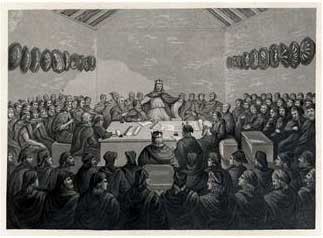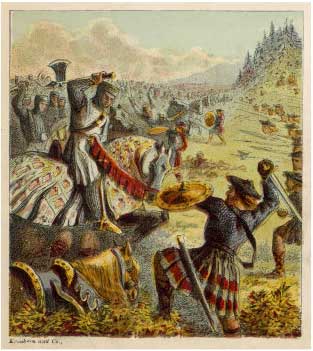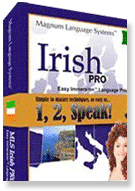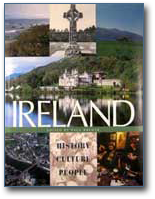High Kings of Ireland
 |
The traditional list of supposed Ard RÃ, or the High Kings of Ireland, started from the Milesian Conquest. According to legend, the earliest inhabitants of Ireland were a god-like race called the Tuatha De Danann. Legend goes on to tell how these people were defeated by the forces of Milesius, an Iberian warrior of the 15th century B.C. The victorious invaders were led by two men, Eireamhón (Eremon) and Éibhear (Eber), the former becoming the sole king of Ireland after killing the latter in a battle. Eireamhón ruled from a court located on the hill of Tara.
The list should be viewed with a skeptical eye for several reasons. The whole succession is based on legend and modern historians do not accept this. They prefer to think of the Celtic conquest as being more cultural than military, and taking place over a period of many centuries rather than in a specific year.
It is highly unlikely that any High King ever really had absolute power over the entire island. Though the numbering starts in 1434 B.C., with Eber and Eremon, the first Milesian rulers, the Annals of the Four Masters name many pre-Celtic rulers that do not appear in the list. Irish history, in the centuries before the birth of Christ, is a combination of legend, folklore, and myth. A good framework of names, dates, and chronologies of these times is the Annala Rioghacta Eireann, or the Annals of the Four Masters. The chief compiler of the work was Michael O'Clery, a brother of the Order of St. Francis, who was born in 1580. He was sent to Ireland to gather material for a history of the country. He was not a priest but apparently was allowed access, among other repositories of history, to the library of Archbishop James Ussher of the Church of Ireland. Ussher had earned an international reputation as a meticulous scholar in biblical chronology and church history.
O'Clery's three collaborators were Farfassa O'Mulconry, Peregrine O'Duigenan, and Peregrine O'Clery. After years of collecting material, these "four masters" settled in 1632 in the Franciscan convent of Drowes, county Donegal, situated on the bank of the Bundrowes River where it forms the county boundary between Leitrim and Donegal, and produced their Annals. The great Irish scholar John O'Donovan made a classic translation of the Annals in which the Irish text is given with a translation into English. O'Donovan's work is published in seven quarto volumes that include copious historical, genealogical and topographical notes. It is titled 'Annala Rioghachta Eireann, Annals of the Kingdom of Ireland, by the Four Masters, from the earliest period to the year 1616', by John O'Donovan.
Although the earliest of the kings in these lists are legendary characters, the later kings are historical persons. The first king to truly have power throughout Ireland was Niall I Naoighiallach, 379-405 A.D. His descendants were known as the Uà Néill, and they ruled for the next several centuries. However, the title of High King (Ard RÃ) was not actually used until later.
The line of Irish High Kings was ended shortly after the Anglo-Norman invasion of 1169. In 1315, Edward Bruce (Eideard de Brus), brother of Robert the King of Scotland (Roibeirt de Brus), was invited to Ireland by the King of Ulster, Domhnall Ó Néill, in the hope that he would drive the English invaders out of Ireland as his brother had done in Scotland. In 1316, he was crowned King of Ireland under the title of Éadbhard I or Edward I. He set up his Headquarters at Dundalk (Dún Dealgan) and there, on the 1st of May 1316, in the presence of the Scotch and Irish, he was crowned King of Ireland. After early successes at Connor, Cells and Arscoll (near Athy in county Kildare), de Brus failed to capture Dublin or Limerick and was forced back north where he was killed at the Battle of Faughart in 1318, never having ruled the entire country. While the battle raged, a powerful English knight, Sir John de Maupas, rushed into the Scottish ranks, sought out Edward Bruce (de Brus), with whom he engaged in single combat, and both fell mortally wounded. Edward Bruce was the last of the High Kings of Ireland and he was number 185.
 |
Click here to view the entire chronological list of the High Kings of Ireland.
Disclaimer: LittleShamrocks.com is an affiliate website that receives commissions from sales of the products listed. We have purchased and sampled many, but not all, of the products on these pages.
© Copyright LittleShamrocks.com. All Rights Reserved.








